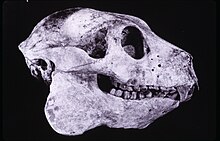| Babakotia Temporal range:
| |
|---|---|

| |
| Babakotia radofilai skull | |
| Scientific classification | |
| Domain: | Eukaryota |
| Kingdom: | Animalia |
| Phylum: | Chordata |
| Class: | Mammalia |
| Order: | Primates |
| Suborder: | Strepsirrhini |
| Family: | †Palaeopropithecidae |
| Genus: | †Babakotia Godfrey et al., 1990[2] |
| Species: | †B. radofilai
|
| Binomial name | |
| †Babakotia radofilai Godfrey et al., 1990[1]
| |

| |
| Subfossil sites forBabakotia radofilai[3] | |
Babakotia is an extinct genus of medium-sized lemur, or strepsirrhine primate, from Madagascar that contains a single species, Babakotia radofilai. Together with Palaeopropithecus, Archaeoindris, and Mesopropithecus, it forms the family Palaeopropithecidae, commonly known as the sloth lemurs. The name Babakotia comes from the Malagasy name for the indri, babakoto, to which it and all other sloth lemurs are closely related. Due to its mix of morphological traits that show intermediate stages between the slow-moving smaller sloth lemurs and the suspensory large sloth lemurs, it has helped determine the relationship between both groups and the closely related and extinct monkey lemurs.
Babakotia radofilai and all other sloth lemurs share many traits with living sloths, demonstrating convergent evolution. It had long forearms, curved digits, and highly mobile hip and ankle joints. Its skull was more heavily built than that of indriids, but not as much as in the larger sloth lemurs. Its dentition is similar to that of all other indriids and sloth lemurs. It lived in the northern part of Madagascar and shared its range with at least two other sloth lemur species, Palaeopropithecus ingens and Mesopropithecus dolichobrachion. Babakotia radofilai was primarily a leaf-eater (folivore), though it also ate fruit and hard seeds. It is known only from subfossil remains and may have died out shortly after the arrival of humans on the island, but not enough radiocarbon dating has been done with this species to know for certain.